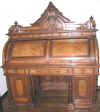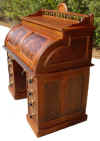|
| Early Desks |
Antique Office Desks
Desks with flat tops at the height of tables and drawers were common
throughout the period since the 1840s. In addition to providing writing surfaces and drawers, some desks
provided pigeonholes for documents and slots for ledgers. This exhibit is limited to desks of the latter
types that were marketed in the U.S.
Desks with writing surfaces, drawers, pigeonholes, and slots for ledgers existed
in England by the end of the 17th century. (See illustrations in Mark Bridge, An
Encyclopedia of Desks, 1988.)
| Standard Office Desks, 1840s-1880s | ||
| 1840s & 1850s | Single Standing Desk, Piano Sitting Desk, and third desk, Stephen Smith, Boston, MA, 1846 billhead |
 Four styles of desks, Stephen Smith's Desk Warehouse, Boston, MA, 1854 ad. |
|
. |
 Desk, E. P. Wright, Worcester, MA, 1854 ad |
Abraham Lincoln's Desk, Springfield, IL |
| 1860s |   1862 |
 J.W. Schermerhorn & Co., NY, NY, 1869. |
| 1870s
|
 J. Brewi & Co, Designs of Writing Desks, NY, NY, 1871 ad |
 J. Brewi & Co, NY, NY, 1871 ad |
|
|
 J. Brewi & Co, NY, NY, 1871 ad |
 H. Mott & Co., 1873 billhead. Also J. Brewi & Co., NY, NY, 1871 |
|
|
 President's Desk, J. Brewi & Co, NY, NY, 1871 ad Because a desk of this style appears in a c.1856
photograph of a Western Union office, one can infer that this style
was introduced by c. 1856 or, alternatively, that the photo in question is
not correctly dated.. |
  Pigeon-holes and ledger case in desk similar to the one pictured immediately above |
|
Cylinder Desks: There is a distinction between cylinder desks and roll-top
desks (a.k.a. curtain desks). On
cylinder desks, the top that swings into place to cover the writing
surface is not flexible, and the track is therefore a circular arc. On
roll-top desks, the top that rolls into place is flexible, and the track
typically has an S shape, although in some cases it is a circular arc. |
Mark Bridge (p. 42) reports that what may have been the first cylinder desk was built for Louis XV during 1760-69. Cylinder desks were popular in France for at least the following century. A c. 1776 French cylinder desk is on display at the National Gallery of Art, Washington, DC. Bridge (pp. 70-71) indicates that tambour, or roll-top, writing tables with drawers and pigeonholes existed in England by 1788, but these were much smaller than the roll-top desks that were popular in the U.S. a century later.  Cylinder Desk, J. Brewi & Co., NY, NY, 1871 ad  Cylinder Desk, Melior, Lingemann & Co., NY, NY, 1874 ad |
"Sudden Death of the Hon. William F. Havemeyer in his Office," New York, NY, Frank Leslie's Illustrated Newspaper, Dec. 1874. Havemeyer (b.1804) was mayor of NYC during 1848-49 and died on Nov. 30, 1874.  Cylinder Desk, open & closed, Sugg & Beiersdorf Co., Chicago, IL, 1883 ad  Cylinder Desks, F. Mayer & Co., Chicago, IL, 1883 ad |
| Fred C. Cutler: In 1875, Fred H. Cutler, of Buffalo, NY, was awarded a patent for a desk with a flexible top that pulled up rather than down (see patent illustration immediately to right). We do not know whether this design was manufactured, but it appears to be a predecessor of a roll-top desk. Notice that Fred H. Cutler, D.L. Ransom & Co. (see row immediately below), and Abner Cutler (two rows below) were all in Buffalo, NY. |  Patent illustration for a desk with a flexible pull-up cover, Fred H Cutler, Buffalo, NY, 1875 |
. |
| Ransom Desks: In 1876, D. L. Ransom & Co., Buffalo, NY, advertised large office desks with flexible pull-down tops. These desks were exhibited at the 1876 Centennial Exposition. Arguably these were roll-top desks, although the word "roll-top" was not used to describe them. At a minimum, they were precursors of the roll-top desk. |   Ransom Desk No. 1 for Sitting, 1876 ad The writing surface was at a height suitable for a sitting person. |
  Ransom Desk No. 1 for Standing, 1876 ad The writing surface was at a height suitable for a standing person. |
| 1880s Roll-top Desks: The earliest illustration and use of the term "roll top desk" that we have found are on the 1880 billhead below. The term "roll top desk" appears in the handwritten line. |
 Patent illustration for a roll-top desk, Abner Cutler, Buffalo, NY, 1881. In 1881, Abner Cutler of Buffalo, NY, presumably a relative of Fred H. Cutler (see two rows above), was awarded the earliest patent we have found for a true roll-top desk (although the patent did not use the term "roll-top"). Abner Cutler filed the application for this patent in 1880. |
 Roll-top Secretary Desk, Geo. H. Derby & Co., Boston, MA, 1884 ad. "The Fifth Illustrated Catalogue of the Derby Roll-Top Desks," published in 1884, stated that "Thousands of Derby Roll-Top Desks are now in use." This suggests that production of Derby Roll-Top Desks may have begun c. 1880. |
| The earliest use of the
term "roll-top desk" that we have found was in 1881. The
catalog for the Fourteenth Exhibition of the Massachusetts Charitable
Mechanic Association, Boston, MA, 1881, p. 98, states that Smith
& Co., Boston, MA, exhibited a "Roll-Top Desk." The
Literary World, Oct. 22, 1881, p. 370, states that "...a publishing
house does not necessarily consist in frescoed ceilings, black walnut
counters, roll-top desks, and Brussels carpets."
The earliest advertisement we have found for a roll-top desk was published in 1884; we have found 1884 advertisements for roll-top desks made by numerous companies. The earliest illustration we have seen of an office with a roll-top desk dates from 1887. |
. Roll Top Desk, High Roll, Extra Grade, The Globe Co., Cincinnati, OH, 1894/95 catalog. At $100 in oak or walnut or $125, this was close to the top end of the roll top desks in the catalog. |
 Roll-top Desk, Frederick Douglass's Study, Cedar Hill, Douglass home 1877-95, Anacostia, Washington, DC |
| Filing Cabinets for the Tops of Desks: Manufacturers marketed filing units that were designed to be placed on top of flat and roll-top desks. |  National Office Furniture, M.J. Wise, Sole Proprietor, Washington, DC, 1884 catalog. |
 Roll-Top Desk with Combination Cabinet of Six Shannon and two US Document Drawers on Top, Schlicht & Field Co., Rochester, NY, 1886 ad |
| . |
|
 Office with filing unit on top of roll-top desk, c. 1900 |
|
Ross Desks: Ross Desks were made by the Forest City Furniture
Co., Rockford, IL
|
 Ross Curtain Desk, closed & open, patented 1883 |
 Ross Perfection Desk, 63 compartments, 15 drawers, closed & open, 1884 ad |
| Wirts & Scholle Desks: The images in this row come from the 1885 Office Furniture Catalog of Wirts & Scholle, Chicago, IL. These desks incorporate elements from desks that were marketed in the 1840s-1880s. | 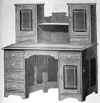
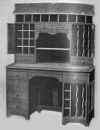 |

 |
| Luxury Desks ~ 1870s & 1880s | ||
|
Wooton Cabinet Secretary Wooton Desk Co., then Wooton Desk Mfg. Co., Indianapolis, IN Patented 1874 |
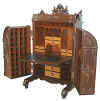
Photograph courtesy of Antiquarian Traders, Beverly Hills, CA  Wooton advertised this item during 1874-84 and probably later. |
 Detail of Pigeon-Holes on right door of Wooton Cabinet Office Secretary |
| Wooton Rotary Desk Wooton Desk Mfg. Co. (as of 1882), then Wooton Office Desk Co. Indianapolis, IN, then Richmond, IN Patented 1876 Advertised 1882-92 1887 Price $60-$85 |
Wooton advertised this desk in 1882.  Wooton advertised this desk in 1883 and probably later. |
"Swing Pedestal Desks" of this style, with pigeon-holes, were advertised in the 1895 Tyler Office Fixture Co. Catalog, St. Louis, MO. (Hagley Museum and Library) |
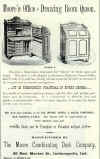 Moore Combination Desks Moore Combination DesksMoore Combination Desk Co. Indianapolis, IN Patented 1882 |
 Insurance King Desk, contained 129 compartments, 1882 ad |
 Photograph courtesy of Antiquarian Traders. |
| Moore combination desks were produced in standard, extra,
and superior grades. Standard grade combination desks were $110 to
$185. Extra grade desks were 40% to 50% more expensive.
Superior were more expensive.
|

 Office Queen, Moore Combination Desk Co., Indianapolis, IN |
|
| Indianapolis Cabinet Company
Desks Indianapolis Cabinet Co. Indianapolis, IN Patented 1886 Advertised 1890 On Mar. 23, 1886, the president of the Indianapolis Cabinet Company, Indianapolis, IN, obtained US Patent No. 338,632 for a double-pedestal desk with two hinged Wooton-like sections that were attached to the upper part of the desk and that opened to the sides. The desks produced by this company probably did not fall in the luxury category, but they are included here because of their relationship to Wooton desks. The company went out of business in the early 1890s. |
1890 ad |
. |
|
Standing Desks |
||
| Standing or book-keepers' desks were sold from the1840s, if not earlier, until after 1900. |  Standing Desk, J. Brewi & Co, NY, NY, 1871 ad |
Book-Keeping Office with book-keepers' desks and a desk in the style or Wooton or Moore, G. L. Howe and O. M. Powers, The Secrets of Success in Business, 1883. |
| Why did book-keepers stand while they worked? "It is conceded by all that a book-keeper's desk should be of sufficient hight [spelling in the original] to require him to stand while at his work, for the posting and checking from one large book to another necessitates constant moving, and it would be very inconvenient for the accountant to seat himself and then rise again whenever it become necessary to refer to an entry in another book. The books of an establishment of sufficient size to employ the services of a book-keeper are usually very cumbersome, and should lie upon the counter or desk in an accustomed place, while the book-keeper passes to and fro from book to book, as occasion requires. Many firms will not employ a book-keeper who would attempt to do his work by sitting down. The book-keeper's desk should slant on top, and be provided with a rack [above the slanted surface], for convenience in laying aside indexes, tablets, etc., where they may be easily reached when needed from time to time. Under the desk may be arranged shelves and places for books, or if these are deposited in the safe or vault each night, this would not be necessary." (G. L. Howe and O. M. Powers, The Secrets of Success in Business, 1883, p. 313) The shift toward use of loose-leaf ledgers and book-keeping machine that began in the late 1890s presumably reduced the use of standing desks. However, we have seen advertisements for standing desks as late as 1917. |
 Book-keeper's Desk, Wm. Schwarzwaelder & Co., NY, NY, 1888 ad |
 Double Standing Desk, The Globe Co., Cincinnati, OH, 1894/95 catalog.  Book-Keeper's Desk, G |
| 1890-1910s | ||
In the 1890s and first decade of the 20th
century, roll-top desks were widely
advertised. We have seen ads for traditional style roll-top desks as
late as 1917. We have seen ads for "modern-style"
roll-tops desks during 1909-28. Office with "modern" roll-top desk in background, 1918. |
 Roll-top desk, The Globe Co., Cincinnati, OH, 1894 ad |
 Roll-top Desk with Safe, The Victor Safe and Lock Co., Cincinnati, OH, 1902 ad. |
| The Decline of
the Roll-Top Desk In a 1914 book on the American office, J. William Schulze states, perhaps as prescription as well as description: "The roll top desk is fast disappearing from efficiently managed offices, the chief objection being the fact that it becomes a receptacle for important papers which are forgotten. Also the pigeon holes frequently become filled with 'truck' which might as well be thrown away.... Most papers that are filed in the pigeon holes should be placed in the files where they are accessible to every one who needs them. Moreover, the unnecessary height of a roll top desk cuts off valuable light and air." (The American Office, 2nd ed., Ronald Press, New York, NY, 1914) To the extent that the preceding comments are correct, they apply to all desks with high backs illustrated above that were popular in the second half of the nineteenth century and the first decade of the 20th century. |
||



